GIS Applications for Water Wastewater and Stormwater Systems
Bạn đang xem bản rút gọn của tài liệu. Xem và tải ngay bản đầy đủ của tài liệu tại đây (14.35 MB, 453 trang )
GIS Applications
for Water, Wastewater,
and Stormwater Systems
U.M. Shamsi
Boca Raton London New York Singapore
A CRC title, part of the Taylor & Francis imprint, a member of the
Taylor & Francis Group, the academic division of T&F Informa plc.
Library of Congress Cataloging-in-Publication Data
Shamsi, U. M. (Uzair M.)
GIS applications for water, wastewater, and stormwater systems / U.M. Shamsi.
p. cm.
Includes bibliographical references and index.
ISBN 0-8493-2097-6 (alk. paper)
1. Water—Distribution. 2. Sewage disposal. 3. Runoff—Management. 4. Geographic
information systems. I. Title.
TD482.S53 2005
628.1—dc22
2004057108
This book contains information obtained from authentic and highly regarded sources. Reprinted material
is quoted with permission, and sources are indicated. A wide variety of references are listed. Reasonable
efforts have been made to publish reliable data and information, but the author and the publisher cannot
assume responsibility for the validity of all materials or for the consequences of their use.
Neither this book nor any part may be reproduced or transmitted in any form or by any means, electronic
or mechanical, including photocopying, microfilming, and recording, or by any information storage or
retrieval system, without prior permission in writing from the publisher.
The consent of CRC Press does not extend to copying for general distribution, for promotion, for creating
new works, or for resale. Specific permission must be obtained in writing from CRC Press for such
copying.
Direct all inquiries to CRC Press, 2000 N.W. Corporate Blvd., Boca Raton, Florida 33431.
Trademark Notice: Product or corporate names may be trademarks or registered trademarks, and are
used only for identification and explanation, without intent to infringe.
Visit the CRC Press Web site at www.crcpress.com
© 2005 by CRC Press
No claim to original U.S. Government works
International Standard Book Number 0-8493-2097-6
Library of Congress Card Number 2004057108
Printed in the United States of America 1 2 3 4 5 6 7 8 9 0
Printed on acid-free paper
Dedication
Dedicated to my beloved wife, Roshi, and my children,
Maria, Adam, and Harris
Preface
To fully appreciate the benefits of GIS applications consider the following
hypothetical scenario. On March 10, 2004, following a heavy storm event, a sewer
customer calls the Sewer Authority of the City of Cleanwater to report minor
basement flooding without any property damage. An Authority operator immediately
starts the GIS and enters the customer address. GIS zooms to the resident property
and shows all the sewers and manholes in the area. The operator queries the inspection data for a sewer segment adjacent to the customer property and finds that a
mini movie of the closed-circuit television (CCTV) inspection dated July 10, 1998,
is available. The operator plays the movie and sees light root growth in the segment.
A query of the maintenance history for that segment indicates that it has not been
cleaned since April 5, 1997. This information indicates that the roots were never
cleaned and have probably grown to “heavy” status. The operator highlights the
sewer segment, launches the work order module, and completes a work order form
for CCTV inspection and root removal, if necessary. The export button saves the
work order form and a map of the property and adjacent sewers in a PDF file. The
operator immediately sends the PDF file by e-mail to the Authority’s sewer cleaning
contractor. The entire session from the time the customer called the Authority office
took about 30 min. The operator does not forget to call the customer to tell him that
a work order has been issued to study the problem. This book presents the methods
and examples required to develop applications such as this.
The days of the slide rule are long gone. Word processors are no longer considered cutting-edge technology. We are living in an information age that requires us
to be more than visionaries who can sketch an efficient infrastructure plan. This
tech-heavy society expects us to be excellent communicators who can keep all the
stakeholders — the public, the regulators, or the clients — “informed.” New information and decision support systems have been developed to help us to be good
communicators. GIS is one such tool that helps us to communicate geographic or
spatial information. The real strength of GIS is its ability to integrate information.
GIS helps decision makers by pulling together crucial bits and pieces of information
as a whole and showing them the “big picture.” In the past 10 years, the number of
GIS users has increased substantially. Many of us are using GIS applications on the
Internet and on wireless devices without even knowing that we are using a GIS.
Experts believe that in the near future, most water, wastewater, and stormwater
system professionals will be using the GIS in the same way they are now using a
word processor or spreadsheet. Except for the computer itself, no technology has
so revolutionized the water industry. The time has come for all the professionals
involved in the planning, design, construction, and operation of water, wastewater,
and stormwater systems to enter one of the most promising and exciting technologies
of the millennium in their profession — GIS applications.
According to some estimates, more than 80% of all the information used by water and
sewer utilities is geographically referenced.
This book was inspired from a continuing education course that the author has
been teaching since 1998 for the American Society of Civil Engineers (ASCE).
Entitled ‘‘GIS Applications in Water, Wastewater and Stormwater Systems,” the
seminar course has been attended by hundreds of water, wastewater, and stormwater
professionals in major cities of the United States. Many models, software, examples,
and case studies described in the book (especially those from Pennsylvania) are
based on the GIS projects worked on or managed by the author himself.
This is my second GIS book for water, wastewater, and stormwater systems. The
first book, GIS Tools for Water, Wastewater, and Stormwater Systems, published by
American Society of Civil Engineers (ASCE) Press in 2002, was a huge success.
The first printing was sold out, and the book achieved ASCE Press’s best-seller
status within months of publication. Whereas the first book focused on GIS basics
and software and data tools to develop GIS applications, this second book focuses
on the practical applications of those tools. Despite the similarity of the titles, both
books cover different topics and can be read independent of each other.
STYLE OF THE BOOK
This book has been written using the recommendations of the Accreditation
Board for Engineering and Technology (ABET) of the U.S. and the American Society
of Civil Engineers’ (ASCE) Excellence in Civil Engineering Education (ExCEEd)
program. Both of these organizations recommend performance- (or outcome-) based
learning in which the learning objectives of each lecture (or chapter) are clearly
stated up front, and the learning is measured in terms of achieving these learning
objectives. Each chapter of this book accordingly starts with learning objectives for
that chapter and ends with a chapter summary and questions. Most technical books
are written using the natural human teaching style called deductive, in which principles are presented before the applications. In this book, an attempt has been made
to organize the material in the natural human learning style called inductive, in which
examples are presented before the principles. For example, in most chapters, case
studies are presented before the procedures are explained. The book has numerous
maps and illustrations that should cater well to the learning styles of “visual learners”
— GIS, after all is regarded as a visual language.
The primary learning objective of this book is to document GIS applications for water,
wastewater, and stormwater systems. This book will show you how to use GIS to make tasks
easier to do and increase productivity, and hence, save time and money in your business.
ORGANIZATION OF THE BOOK
There are 17 chapters in this book, organized as follows:
• Chapter 1, GIS Applications: Describes why GIS applications are important and
how they are created
• Chapter 2, Needs Analysis: Explains how to avoid potential pitfalls of GIS implementation by starting with a needs analysis study
The next five chapters describe four GIS-related technologies that are very
beneficial in developing GIS applications:
• Chapter 3, Remote Sensing Applications: Shows how to use satellite imagery in
GIS applications
• Chapter 4, DEM Applications: Describes the methods of incorporating digital
elevation model (DEM) data
• Chapter 5, GPS Applications: Discusses how to benefit from global positioning
system (GPS) technology
• Chapter 6, Internet Applications: Explains the applications of Internet technology
in serving GIS maps on the Internet
• Chapter 7, Mobile GIS: Provides information on using GIS in the field for inspection and maintenance work
The GIS applications that are of particular importance to water industry professionals are: Mapping, Monitoring, Modeling, and Maintenance. These four Ms define
some of the most important activities for efficient management of water, wastewater,
and stormwater systems, and are referred to as the “4M applications” in this book.
The next ten chapters focus on these four Ms.
• Chapter 8, Mapping: Describes how to create the first M of the 4M applications
• Chapter 9, Mapping Applications: Describes examples of the first M of the 4M
applications
• Chapter 10, Monitoring Applications: Describes the applications of the second M
of the 4M applications
• Chapter 11, Modeling Applications: Describes the applications of the third M of
the 4M applications
• Chapter 12, Water Models: Describes examples of the third M of the 4M applications for modeling water distribution systems
• Chapter 13, Sewer Models: Describes examples of the third M of the 4M applications for modeling sewage collection systems
• Chapter 14, AM/FM/GIS Applications: Describes automated mapping/facilities
management/geographic information system (AM/FM/GIS) software tools for
implementing the fourth M of the 4M applications
• Chapter 15, Maintenance Applications: Describes the applications of the fourth
M of the 4M applications
• Chapter 16, Security Planning and Vulnerability Assessment: Discusses GIS applications for protecting water and wastewater systems against potential terrorist
attacks
• Chapter 17, Applications Sampler: Presents a collection of recent case studies
from around the world
Acknowledgments
Case studies presented in Chapter 17, Applications Sampler, were written specially for publication in this book by 18 GIS and water industry experts from 6
countries (Belgium, Bulgaria, Czech Republic, Denmark, Spain and the United States)
in response to my call for case studies distributed to various Internet discussion
forums. I thank these case study authors for their contributions to this book:
•
•
•
•
•
•
•
•
Bart Reynaert, Rene Horemans, and Patrick Vercruyssen of Pidpa, Belgium
Carl W. Chen and Curtis Loeb of Systech Engineering, Inc., San Ramon, California
Dean Trammel, Tucson Water, Tucson, Arizona
Ed Bradford, Roger Watson, Eric Mann, Jenny Konwinski of Metropolitan
Sewerage District of Buncombe County, North Carolina
Eric Fontenot of DHI, Inc., Hørsholm, Denmark
Milan Suchanek and Tomas Metelka of Sofiyska Voda A.D., Sofia, Bulgaria
Peter Ingeduld, Zdenek Svitak, and Josef Drbohlav of Praûská vodohospodáská
spolenost a.s. (Prague stockholding company), Prague, Czech Republic
Hugo Bartolin and Fernando Martinez of Polytechnic University of Valencia,
Spain
I also thank the following organizations and companies for providing information for this book: American Society of Civil Engineers, American Water Works
Association, Azteca Systems, CE Magazine, CH2M Hill, Chester Engineers, Computational Hydraulics International, Danish Hydraulic Institute (DHI), Environmental
Systems Research Institute, Geospatial Solutions Magazine, GEOWorld Magazine,
Haestad Methods, Hansen Information Technology, Journal of the American Water
Resources Association, Journal of the American Water Works Association, MWH Soft,
Professional Surveyor Magazine, USFilter, Water Environment Federation, and Water
Environment & Technology Magazine. Some information presented in this book is
based on my collection of papers and articles published in peer-reviewed journals,
trade magazines, conference proceedings, and the Internet. The authors and organizations of these publications are too numerous to be thanked individually, so I thank
them all collectively without mentioning their names. Their names are, of course,
included in the Reference section.
Finally, I would like to thank you for buying the book. I hope you will find the
book useful in maximizing the use of GIS in your organization to make things easier
to do, increase productivity, and save time and money.
About the Author
Uzair (Sam) M. Shamsi, Ph.D., P.E., DEE is director of
the GIS and Information Management Technology division
of Chester Engineers, Pittsburgh, Pennsylvania, and an
adjunct assistant professor at the University of Pittsburgh,
where he teaches GIS and hydrology courses. His areas of
specialization include GIS applications and hydrologic and
hydraulic (H&H) modeling. He has been continuing
education instructor for the American Society of Civil
Engineers (ASCE) and an Environmental Systems Research
Institute (ESRI)-authorized ArcView® GIS instructor since
1998. He has taught GIS courses to more than 500
professionals throughout the United States, including a course on “GIS Applications
in Water, Wastewater, and Stormwater Systems” for ASCE. Sam earned his Ph.D.
in civil engineering from the University of Pittsburgh in 1988. He has 20 years of
GIS and water and wastewater engineering experience in teaching, research, and
consulting. His accomplishments include more than 120 projects and over 100
lectures and publications, mostly in GIS applications. His previous book, GIS Tools
for Water, Wastewater, and Stormwater Systems, was an ASCE Press best seller. He
is the recipient of the ASCE’s Excellence in Civil Engineering Education (EXCEED)
training and is a licensed professional engineer in Pennsylvania, Ohio, and West
Virginia. In addition to ASCE, he is a member of the American Water Resources
Association, the Water Environment Foundation, and the American Water Works
Association.
E-mail:
Web site: www.GISApplications.com
GIS is an instrument for implementing geographic thinking.
Jack Dangermond (1998)
Iron rusts from disuse; water loses its purity from stagnation and in cold weather
becomes frozen; even so does inaction sap the vigors of the mind.
Leonardo da Vinci (1452–1519)
Life is like a sewer…what you get out of it depends on what you put into it.
Tom Lehrer (1928–)
Times of general calamity and confusion create great minds. The purest ore is
produced from the hottest furnace, and the brightest thunderbolt is elicited from the
darkest storms.
Charles Caleb Colton (1780–1832)
Contents
Chapter 1
GIS Applications
Learning Objective ....................................................................................................2
Major Topics ..............................................................................................................2
List of Chapter Acronyms .........................................................................................2
Introduction................................................................................................................2
What Are GIS Applications? ....................................................................................3
History of GIS Applications .....................................................................................4
4M Applications .......................................................................................................6
Advantages and Disadvantages of GIS Applications .............................................. 6
Advantages .......................................................................................................7
GIS Applications Save Time and Money.............................................7
GIS Applications Are Critical to Sustaining GIS Departments...........7
GIS Applications Provide the Power of Integration............................8
GIS Applications Offer a Decision Support Framework.....................8
GIS Applications Provide Effective Communication Tools.................9
GIS Applications Are Numerous..........................................................9
Disadvantages.................................................................................................12
Success Stories ........................................................................................................13
San Diego .......................................................................................................13
Boston.............................................................................................................13
Cincinnati .......................................................................................................13
Knoxville ........................................................................................................14
Dover ..............................................................................................................14
Charlotte .........................................................................................................14
Albany County ...............................................................................................14
GIS Applications Around the World..............................................................15
Evolving GIS Applications and Trends...................................................................15
Future Applications and Trends ..............................................................................16
GIS Application Development Procedure ...............................................................19
Application Programming .......................................................................................20
GIS-Based Approach......................................................................................20
GIS Customization.............................................................................20
Scripting .............................................................................................20
Extensions ..........................................................................................21
External Programs..............................................................................23
Application-Based Approach .........................................................................24
Useful Web Sites .....................................................................................................24
Chapter Summary ....................................................................................................24
Chapter Questions....................................................................................................25
Chapter 2
Needs Analysis
Learning Objective ..................................................................................................28
Major Topics ............................................................................................................28
List of Chapter Acronyms .......................................................................................28
Ocean County’s Strategic Plan................................................................................28
Introduction..............................................................................................................28
Needs Analysis Steps...............................................................................................29
Step 1. Stakeholder Identification..................................................................30
Step 2. Stakeholder Communication .............................................................30
Introductory Seminar .........................................................................31
Work Sessions and Focus Groups .....................................................31
Interviews ...........................................................................................31
Step 3. Resource Inventory............................................................................32
Step 4. Need Priorities ...................................................................................33
Step 5. System Design ...................................................................................33
Data Conversion (Mapping)...............................................................33
Database .............................................................................................34
Software Selection .............................................................................36
Hardware Selection ............................................................................37
User Interface .....................................................................................38
Step 6. Pilot Project .......................................................................................40
Step 7. Implementation Plan..........................................................................41
Step 8. Final Presentation ..............................................................................43
Needs Analysis Examples .......................................................................................43
Pittsburgh, Pennsylvania ................................................................................43
Borough of Ramsey, New Jersey...................................................................44
The City of Bloomington, Indiana ................................................................45
San Mateo County, California .......................................................................45
Chapter Summary ....................................................................................................45
Chapter Questions....................................................................................................46
Chapter 3
Remote Sensing Applications
Learning Objective ..................................................................................................48
Major Topics ............................................................................................................48
List of Chapter Acronyms .......................................................................................48
Albany County’s Remote Sensing Application.......................................................48
Introduction..............................................................................................................49
Remote Sensing Applications..................................................................................51
Remote Sensing Satellites .......................................................................................52
Spatial Resolution....................................................................................................53
Low-Resolution Satellite Data.......................................................................53
Medium-Resolution Satellite Data.................................................................54
High-Resolution Satellite Data ......................................................................56
High-Resolution Satellites .................................................................56
High-Resolution Imagery Applications .............................................58
Data Sources ..................................................................................................59
Digital Orthophotos .................................................................................................59
USGS Digital Orthophotos ............................................................................60
Case Study: Draping DOQQ Imagery on DEM Data.......................62
Examples of Remote Sensing Applications ............................................................62
LULC Classification ......................................................................................62
Soil Moisture Mapping ..................................................................................65
Estimating Meteorological Data ....................................................................66
Geographic Imaging and Image Processing Software............................................66
ERDAS Software Products ............................................................................66
ERDAS Software Application Example ............................................68
ArcView Image Analysis Extension ..............................................................69
MrSID.............................................................................................................69
PCI Geomatics ...............................................................................................70
Blue Marble Geographics ..............................................................................71
Future Directions .....................................................................................................72
Useful Web Sites .....................................................................................................73
Chapter Summary ....................................................................................................73
Chapter Questions....................................................................................................73
Chapter 4
DEM Applications
Learning Objective ..................................................................................................76
Major Topics ............................................................................................................76
List of Chapter Acronyms .......................................................................................76
Hydrologic Modeling of the Buffalo Bayou Using GIS and DEM Data ..............76
DEM Basics .............................................................................................................77
DEM Applications ...................................................................................................79
Three-Dimensional (3D) Visualization..........................................................79
DEM Resolution and Accuracy...............................................................................80
USGS DEMs............................................................................................................81
USGS DEM Formats .....................................................................................82
National Elevation Dataset (NED) ....................................................83
DEM Data Availability ............................................................................................83
DEM Data Creation from Remote Sensing ............................................................84
Image Processing Method..............................................................................84
Data Collection Method.................................................................................84
LIDAR............................................................................................................85
IFSAR.............................................................................................................85
DEM Analysis..........................................................................................................86
Cell Threshold for Defining Streams.............................................................86
The D-8 Model...............................................................................................86
DEM Sinks.....................................................................................................87
Stream Burning ..............................................................................................88
DEM Aggregation ..........................................................................................88
Slope Calculations..........................................................................................88
Software Tools .........................................................................................................88
Spatial Analyst and Hydro Extension............................................................90
ARC GRID Extension ...................................................................................93
IDRISI ............................................................................................................94
TOPAZ ...........................................................................................................95
Case Studies and Examples.....................................................................................95
Watershed Delineation ...................................................................................95
Sewershed Delineation.................................................................................101
Water Distribution System Modeling ..........................................................103
WaterCAD Example.........................................................................104
Useful Web Sites ...................................................................................................105
Chapter Summary ..................................................................................................105
Chapter Questions..................................................................................................106
Chapter 5
GPS Applications
Learning Objective ................................................................................................108
Major Topics ..........................................................................................................108
List of Chapter Acronyms .....................................................................................108
Stream Mapping in Iowa .......................................................................................108
GPS Basics ............................................................................................................109
GPS Applications in the Water Industry ...............................................................110
Surveying......................................................................................................111
Fleet Management........................................................................................111
GPS Applications in GIS.......................................................................................111
GPS Survey Steps..................................................................................................112
GPS Equipment .....................................................................................................113
Recreational GPS Equipment ......................................................................113
Basic GPS Equipment..................................................................................114
Advanced GPS Equipment ..........................................................................115
Survey Grade GPS Equipment..............................................................................116
Useful Web Sites ...................................................................................................117
Chapter Summary ..................................................................................................117
Chapter Questions..................................................................................................118
Chapter 6 Internet Applications
Learning Objective ................................................................................................120
Major Topics ..........................................................................................................120
List of Chapter Acronyms .....................................................................................120
Dublin’s Web Map.................................................................................................120
Internet GIS ...........................................................................................................122
Internet Security...........................................................................................123
Internet GIS Software............................................................................................124
Internet GIS Applications ......................................................................................124
Data Integration............................................................................................124
Project Management ....................................................................................124
3D Visualization Applications .....................................................................126
Case Studies...........................................................................................................126
Tacoma’s Intranet and Mobile GIS .............................................................126
Montana’s Watershed Data Information Management System...................127
Useful Web Sites ...................................................................................................128
Chapter Summary ..................................................................................................128
Chapter Questions..................................................................................................128
Chapter 7
Mobile GIS
Learning Objective ................................................................................................130
Major Topics ..........................................................................................................130
List of Chapter Acronyms .....................................................................................130
Mobile GIS Basics.................................................................................................130
Mobile GIS Applications.......................................................................................131
Wireless Internet Technology ................................................................................133
GPS Integration .....................................................................................................133
Useful Web Sites ...................................................................................................134
Chapter Summary ..................................................................................................135
Chapter Questions..................................................................................................135
Chapter 8 Mapping
Learning Objective ................................................................................................138
Major Topics ..........................................................................................................138
List of Chapter Acronyms .....................................................................................138
Los Angeles County’s Sewer Mapping Program..................................................138
Mapping Basics .....................................................................................................139
Map Types ....................................................................................................139
Topology.......................................................................................................139
Map Projections and Coordinate Systems...................................................140
Map Scale.....................................................................................................140
Data Quality .................................................................................................140
Data Errors ...................................................................................................141
Map Accuracy ..............................................................................................141
Map Types..............................................................................................................142
Base Map......................................................................................................142
Digital Orthophotos..........................................................................143
Planimetric Maps .............................................................................143
Small-Scale Maps ............................................................................144
Advantages of GIS Maps ......................................................................................145
GIS Mapping Steps ...............................................................................................147
Needs Analysis.............................................................................................147
Data Collection ............................................................................................148
Data Conversion...........................................................................................148
Capturing Attributes .........................................................................148
Capturing Graphics ..........................................................................149
Digitization........................................................................149
Scanning............................................................................150
Data Conversion Software................................................150
Data Processing............................................................................................153
Data Preparation...............................................................................153
Topological Structuring....................................................................153
Data Management ............................................................................154
Quality Control ................................................................................155
Map Production................................................................................155
Case Studies...........................................................................................................156
Borough of Ramsey, New Jersey.................................................................156
City of Lake Elsinore, California ................................................................158
Allegheny County, Pennsylvania .................................................................159
Useful Web Sites ...................................................................................................159
Chapter Summary ..................................................................................................160
Chapter Questions..................................................................................................160
Chapter 9
Mapping Applications
Learning Objective ................................................................................................162
Major Topics ..........................................................................................................162
List of Chapter Acronyms .....................................................................................162
Customer Service Application in Gurnee .............................................................162
Common Mapping Functions................................................................................164
Thematic Mapping .......................................................................................164
Spatial Analysis............................................................................................164
Buffers ..........................................................................................................164
Hyperlinks ....................................................................................................167
Water System Mapping Applications....................................................................167
MWRA Water System Mapping Project .....................................................167
Service Shutoff Application.........................................................................167
Generating Meter-Reading Routes ..............................................................169
Map Maintenance Application.....................................................................169
Wastewater System Mapping Applications...........................................................169
Public Participation with 3D GIS................................................................169
Mapping the Service Laterals ......................................................................170
Stormwater System Mapping Applications...........................................................173
Stormwater Permits......................................................................................173
Chapter Summary ..................................................................................................175
Chapter Questions..................................................................................................175
Chapter 10 Monitoring Applications
Learning Objective ................................................................................................178
Major Topics ..........................................................................................................178
List of Chapter Acronyms .....................................................................................178
Monitoring Real Time Rainfall and Stream-Flow Data in Aurora.......................178
Monitoring Basics..................................................................................................179
Remotely Sensed Rainfall Data ............................................................................179
Satellite Rainfall Data..................................................................................180
Radar Rainfall Data .....................................................................................181
NEXRAD Rainfall Data ..............................................................................181
NEXRAD Level III Data .................................................................181
Estimating Rainfall Using GIS ....................................................................183
Radar Rainfall Application: Virtual Rain-Gauge Case Study .....................184
Flow-Monitoring Applications ..............................................................................187
SCADA Integration..................................................................................... 187
NPDES-Permit Reporting Applications ............................................................... 188
Monitoring via Internet .........................................................................................189
Monitoring the Infrastructure ................................................................................190
Useful Web Sites ...................................................................................................190
Chapter Summary ..................................................................................................191
Chapter Questions..................................................................................................191
Chapter 11 Modeling Applications
Learning Objectives...............................................................................................194
Major Topics ..........................................................................................................194
List of Chapter Acronyms .....................................................................................194
Temporal-Spatial Modeling in Westchester County .............................................194
H&H Modeling......................................................................................................195
Application Methods .............................................................................................196
Interchange Method ...............................................................................................197
Subbasin Parameter Estimation ...................................................................198
Runoff Curve Number Estimation...............................................................199
Water Quality Modeling Data Estimation ...................................................200
Demographic Data Estimation.....................................................................202
Land-Use Data Estimation...........................................................................204
Interface Method....................................................................................................205
HEC-GEO Interface .....................................................................................207
HEC-GeoHMS .............................................................................................207
HEC-GeoRAS ..............................................................................................207
Watershed Modeling System .......................................................................208
GISHydro Modules ......................................................................................208
GISHydro Prepro .............................................................................209
GISHydro Runoff.............................................................................210
ArcInfo Interface with HEC Programs........................................................210
Intermediate Data Management Programs ..................................................211
Interface Method Case Study ......................................................................212
Integration Method ................................................................................................212
EPA’s BASINS Program ..............................................................................213
BASINS Examples...........................................................................217
MIKE BASIN...............................................................................................218
Geo-STORM Integration .............................................................................219
ARC/HEC-2 Integration ..............................................................................219
Integration Method Case Study ...................................................................220
Which Linkage Method to Use? ...........................................................................221
Useful Web Sites ...................................................................................................222
Chapter Summary ..................................................................................................222
Chapter Questions..................................................................................................223
Chapter 12 Water Models
Learning Objective ................................................................................................226
Major Topics ..........................................................................................................226
List of Chapter Acronyms .....................................................................................226
City of Germantown’s Water Model .....................................................................226
GIS Applications for Water Distribution Systems ................................................227
Development of Hydraulic Models .......................................................................229
Software Examples ................................................................................................231
EPANET .......................................................................................................231
H2ONET™ and H2OMAP™ ..........................................................................232
Demand Allocator ............................................................................235
Skeletonizer ......................................................................................235
Tracer................................................................................................235
WaterCAD™ and WaterGEMS™ ..................................................................235
MIKE NET™.................................................................................................236
Other Programs ............................................................................................237
EPANET and ArcView Integration in Harrisburg.................................................237
Mapping the Model Output Results ............................................................242
Network Skeletonization .......................................................................................243
Estimation of Node Demands ...............................................................................249
Demand-Estimation Case Studies................................................................252
Newport News, Virginia...................................................................252
Round Rock, Texas ..........................................................................252
Lower Colorado River Authority, Texas..........................................253
Estimation of Node Elevations..............................................................................253
Pressure Zone Trace..............................................................................................255
Chapter Summary ..................................................................................................255
Chapter Questions..................................................................................................255
Chapter 13 Sewer Models
Learning Objectives...............................................................................................258
Major Topics...........................................................................................................258
List of Chapter Acronyms .....................................................................................258
MapInfo™ and SWMM Interchange..................................................................... 258
GIS Applications for Sewer Systems ................................................................... 259
Sewer System Modeling Integration .................................................................... 260
Software Examples ............................................................................................... 261
SWMM ................................................................................................................. 261
Useful SWMM Web Sites .................................................................................... 264
SWMM Graphical User Interface .............................................................. 264
XP-SWMM and XP-GIS ................................................................ 266
GIS Data for SWMM ................................................................................. 267
Estimating Green-Ampt Parameters Using STATSGO/SSURGO
GIS Files ...................................................................................... 267
GIS Applications for SWMM .............................................................................. 270
AVSWMM................................................................................................... 270
AVSWMM RUNOFF Extension .................................................... 271
AVSWMM EXTRAN Extension.................................................... 274
Task 1: Create EXTRAN input file .................................... 274
Task 2: Create SWMM EXTRAN output layers in
ArcViewGIS .................................................................... 277
SWMMTools ............................................................................................... 278
AGSWMM .................................................................................................. 280
PCSWMM GIS™.......................................................................................... 281
SWMM and BASINS ................................................................................. 282
SWMMDUET ............................................................................................. 283
AVsand™ ...................................................................................................... 284
Other Sewer Models ............................................................................................. 284
DHI Models................................................................................................. 284
MOUSE ™ ........................................................................................ 284
MIKE SWMM ™ ............................................................................ 285
MOUSE GIS™ ................................................................................. 285
MOUSE GM ™ ................................................................................ 286
InfoWorks™ ................................................................................................. 287
SewerCAD™ and StormCAD™ .................................................................. 289
Sewer Modeling Case Studies.............................................................................. 289
XP-SWMM and ArcInfo Application for CSO Modeling ......................... 289
AM/FM/GIS and SWMM Integration........................................................ 290
SWMM and ArcInfo™ Interface................................................................. 290
Hydra™ and ArcInfo™ Interface .................................................................. 291
Useful Web Sites .................................................................................................. 291
Chapter Summary ................................................................................................. 291
Chapter Questions................................................................................................. 292
Chapter 14 AM/FM/GIS Applications
Learning Objective ................................................................................................294
Major Topics ..........................................................................................................294
List of Chapter Acronyms .....................................................................................294
Hampton’s Wastewater Maintenance Management ..............................................294
Infrastructure Problem ...........................................................................................295
AM/FM/GIS Basics ...............................................................................................297
Automated Mapping (AM) ..........................................................................298
Facilities Management (FM) .......................................................................300
Automated Mapping (AM)/Facilities Management (FM)...........................300
AM/FM/GIS Systems ..................................................................................300
AM/FM/GIS Software ...........................................................................................300
ArcFM ..........................................................................................................302
Cityworks .....................................................................................................304
Chapter Summary ..................................................................................................305
Chapter Questions..................................................................................................305
Chapter 15 Maintenance Applications
Learning Objective ................................................................................................308
Major Topics ..........................................................................................................308
List of Chapter Acronyms .....................................................................................308
Buncombe County’s Sewer System Inspection and Maintenance .......................309
Asset Management ................................................................................................310
GASB 34 Applications ..........................................................................................312
Wet Weather Overflow Management Applications ...............................................312
AutoCAD Map GIS Application for CMOM .............................................313
CCTV Inspection of Sewers..................................................................................314
Convert Existing Video Tapes to Digital Files ............................................315
Digitize Existing VHS Tapes .......................................................................316
WinCan.............................................................................................317
Retrofit Tape Systems with Digital Systems ...............................................317
Record Directly in Digital Format...............................................................319
Linking Digital Movies to GIS....................................................................319
Video Mapping ......................................................................................................321
Thematic Mapping of Inspection Data .................................................................322
Work Order Management ..................................................................................... 325
Water Main Isolation Trace...................................................................................327
Case Studies...........................................................................................................328
Isolation Trace Case Studies........................................................................328
Sewer System Inspections in Washington County ......................................328
Sewer Rehabilitation in Baldwin ................................................................330
Useful Web Sites ...................................................................................................333
Chapter Summary ..................................................................................................333
Chapter Questions..................................................................................................333
Chapter 16 Security Planning and Vulnerability Assessment
Learning Objective ................................................................................................336
Major Topics ..........................................................................................................336
List of Chapter Acronyms .....................................................................................336
GIS Applications in Planning................................................................................336
Security Planning...................................................................................................337
Vulnerability of Water Systems ...................................................................338
Vulnerability of Sewer Systems...................................................................338
GIS Applications in Vulnerability Assessment .....................................................338
Security Modeling Software .................................................................................340
H2OMAP™ Protector................................................................................... 340
WaterSAFE™ ................................................................................................340
VSAT ™ .........................................................................................................342
Security Planning Data Issues...............................................................................342
Useful Web Sites ...................................................................................................343
Chapter Summary ..................................................................................................343
Chapter Questions................................................................................................. 343









